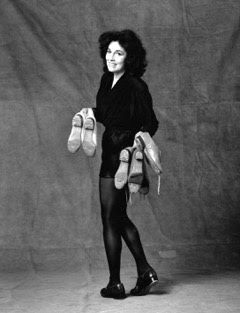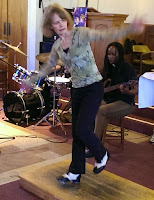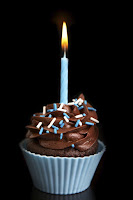 |
| Laraine Goodman's shoes |
Sarah Petronio
Me and my shoes...
 I have funky feet...funky not in the "bring in the funk" way just sensitive feet with bunions. So, I need wide comfortable shoes. I wore the lovely Capezio leather K360 for 20 years. I have had them in white, black, tan and even painted them brown with little silver music notes. I made the “Capezio stop” to buy tap shoes every time I came to the USA from France where we lived. I started with Capezio Master Taps, tried the Tele tone taps when the Master Taps were impossible to find. I also enjoyed the Duo-Tone heel Taps. I beat my feet to all kinds of music especially Be bop and jazz. When I was invited to teach and perform at the Boston Umbrella Tap Festival, I ended the week teaching 35 excited students and got so excited myself that at the end of the class, I jumped up in the air and landed back down with the most terrible pain in my right foot. I decided to ignore the slight swelling on my foot that night because not even a broken foot would have stopped me to be on that stage the following night where I was scheduled to perform with the most incredible line up of artists - Jimmy Slyde, The Nicholas Brothers, Steve Condos, Brenda Bufalino, Savion Glover, Honi Coles, The Jazz Tap Ensemble, LaVaughn Robinson, Eddie Brown and Dianne Walker. I had requested Bross Townsend to inspire me with his piano playing and Major Holley to walk with me to the sound of “Blues in the Closet” and they did. Except for the agonising shooting pains that seemed to go through my Capezio shoes into my dancing feet all went relatively well. THANK YOU MY TAN CAPEZIO K360’s for supporting me as I danced! After the show my foot was as large as a small pumpkin so when I returned home I spent the next few years rediscovering with the help of orthopaedic soles how to continue walking and dancing with one dislocated toe in my right foot. It was then that I switched to Miller and Ben tap shoes offered to me by Avi Miller and Ofer Ben. They were strong, but a bit stiff so I wore them for a year to break them in without the taps till they were ready and very comfortable for me to “hit” the way I wanted. I still wear them and find that they are well made and offer me a powerful sound on stage and when I teach big tap classes.
I have funky feet...funky not in the "bring in the funk" way just sensitive feet with bunions. So, I need wide comfortable shoes. I wore the lovely Capezio leather K360 for 20 years. I have had them in white, black, tan and even painted them brown with little silver music notes. I made the “Capezio stop” to buy tap shoes every time I came to the USA from France where we lived. I started with Capezio Master Taps, tried the Tele tone taps when the Master Taps were impossible to find. I also enjoyed the Duo-Tone heel Taps. I beat my feet to all kinds of music especially Be bop and jazz. When I was invited to teach and perform at the Boston Umbrella Tap Festival, I ended the week teaching 35 excited students and got so excited myself that at the end of the class, I jumped up in the air and landed back down with the most terrible pain in my right foot. I decided to ignore the slight swelling on my foot that night because not even a broken foot would have stopped me to be on that stage the following night where I was scheduled to perform with the most incredible line up of artists - Jimmy Slyde, The Nicholas Brothers, Steve Condos, Brenda Bufalino, Savion Glover, Honi Coles, The Jazz Tap Ensemble, LaVaughn Robinson, Eddie Brown and Dianne Walker. I had requested Bross Townsend to inspire me with his piano playing and Major Holley to walk with me to the sound of “Blues in the Closet” and they did. Except for the agonising shooting pains that seemed to go through my Capezio shoes into my dancing feet all went relatively well. THANK YOU MY TAN CAPEZIO K360’s for supporting me as I danced! After the show my foot was as large as a small pumpkin so when I returned home I spent the next few years rediscovering with the help of orthopaedic soles how to continue walking and dancing with one dislocated toe in my right foot. It was then that I switched to Miller and Ben tap shoes offered to me by Avi Miller and Ofer Ben. They were strong, but a bit stiff so I wore them for a year to break them in without the taps till they were ready and very comfortable for me to “hit” the way I wanted. I still wear them and find that they are well made and offer me a powerful sound on stage and when I teach big tap classes.
Hilary-Marie Michael
 I'm loving and currently wearing The GS1 Tap Boots made by Matt at Dancing Fair. I really enjoy the quality of sound, they're extremely comfortable, there are many options to customize the build (sounding board, shank, insole, material, etc.) and I like the cut and style. I also have a pair of leather oxfords by Matt that I use for recordings and soft shoe performances. Dancing Fair is a small business that has a dancer's comfort, sound and style at the forefront of their mind, and for that, I'm very appreciative.
I'm loving and currently wearing The GS1 Tap Boots made by Matt at Dancing Fair. I really enjoy the quality of sound, they're extremely comfortable, there are many options to customize the build (sounding board, shank, insole, material, etc.) and I like the cut and style. I also have a pair of leather oxfords by Matt that I use for recordings and soft shoe performances. Dancing Fair is a small business that has a dancer's comfort, sound and style at the forefront of their mind, and for that, I'm very appreciative.
Laraine Goodman
 I guess my very first attraction to tap shoes was on the feet of Eleanor Powell in 1964 when I was an apprentice for Summer Stock Theater in West Springfiled, MA. Eleanor was tall and gorgeous and had the lead in a musical bound for Broadway (can’t remember which show it was). My real dive into tap and tap shoes was around 1986, 87 when I stumbled upon a used a used pair of Capezio character shoes with taps at a street fair. They were my size, a perfect 8, and they felt like heaven. As my tap life progressed, I graduated to flat Brenda Bufalino tap shoes (designed by Brenda and Avi Miller and Ofer Ben) They were called Danskys. I wear that brand to this day. I like my taps loose. Also, Thinking about trying out Capezio K360s. During the 90s, Gregory Hines gave me two pairs of his own brand, his design: One a woman’s style, see two tone black and red in photo and a “mens” style, black and dark grey. These days, all shoes should be gender fluid.
I guess my very first attraction to tap shoes was on the feet of Eleanor Powell in 1964 when I was an apprentice for Summer Stock Theater in West Springfiled, MA. Eleanor was tall and gorgeous and had the lead in a musical bound for Broadway (can’t remember which show it was). My real dive into tap and tap shoes was around 1986, 87 when I stumbled upon a used a used pair of Capezio character shoes with taps at a street fair. They were my size, a perfect 8, and they felt like heaven. As my tap life progressed, I graduated to flat Brenda Bufalino tap shoes (designed by Brenda and Avi Miller and Ofer Ben) They were called Danskys. I wear that brand to this day. I like my taps loose. Also, Thinking about trying out Capezio K360s. During the 90s, Gregory Hines gave me two pairs of his own brand, his design: One a woman’s style, see two tone black and red in photo and a “mens” style, black and dark grey. These days, all shoes should be gender fluid.Shoes from top to bottom (see photo at top):
Brenda Bufalino's with one screw taps installed by Rob Rowe
Greg Hines two tone red/black “woman's"
Greg Hines two tone black/grey
Avi, Ofer and Brenda’s Danskys (Black and two tone Black/White)
Real Rockette’s red tap shoe from Rockette’s closet circa 1940s
And, last but not least, my first capezio character shoes found on street
Megan Haungs
 I could dance just like John Bubbles
I could dance just like John Bubbles
Heel drops would be no trouble
I'd tear up that tap mat.
Rhythm time steps would be easy
Syncopation always easy
If I only tapped in flats.
Inspired by Ms. Mable
The feminine enabled
But still keeping it real.
I'd dance like those before us
Who tap danced in the chorus
If I only danced in heels.
 I could dance just like John Bubbles
I could dance just like John BubblesHeel drops would be no trouble
I'd tear up that tap mat.
Rhythm time steps would be easy
Syncopation always easy
If I only tapped in flats.
Inspired by Ms. Mable
The feminine enabled
But still keeping it real.
I'd dance like those before us
Who tap danced in the chorus
If I only danced in heels.
There is the saying that Ginger did everything that Fred did, only backwards and in heels. And certainly their ballroom numbers are among the most elegant icons of romance. But the Fred and Ginger numbers I enjoy most are the conversational tap dances--"Isn't a Lovely Day" from Top Hat, "I'll Be Hard to Handle" from Roberta, "Let Yourself Go" from Follow the Fleet. In these dances, they are side by side or face to face but neither is following or leading but playfully conversing, inventing, surprising each other. Ginger is dressed in slacks--very unusual for the 1930's. Which leads me to the subject of shoes. When I started to tap dance in the late 70's, I first got patent leather Mary Janes, then Freeds, then finally Capezio flats (I don't know if they were called K-360's then). Most of the women I studied with or danced with had similar shoes. We wanted the sound, the solid footing, the headliner professionalism of the flat helped shoes that were worn by our teachers and mentors. The shoes were a statement. We were sometimes (or often) asked why we dressed like men, or why we danced like men, or why don't we wear women's shoes, which meant heels. But of course we were wearing women's shoes, because they were shoes being worn by women. We were just redefining what a women's shoe could be. A shoe in which we could dance upfront, center stage, in which we could invent and converse like our teachers and mentors.
Favorite shoe: Miller and Ben Jazz-Tap Master--love the sound!
Michael "Toes" Tiranoff
 One night in the 90s, Traci Mann, Ginger de Paris, and I were in the the East Village where there used to be a block-long informal flea market by Astor Place. At one stand, Ginger spotted these heavy black and white shoes with taps; more suited to the monster in Young Frankenstein. They happened to be my size, so I brought them. They were maybe five or ten dollars. Well, I set them aside till I went on tour in with the Flying Karamazov Brothers and the New Old Time Chautauqua ( a group of Vaudevillians) in the summer of 1998. At our first stop in Homer, Alaska, we were camped out on the playground track by the high school where we were to do our first shows. Doug Weiselman, the musical director of the band, liked my idea of tap dancing in the show to Caravan. He furiously wrote out charts for the entire band. The arrangement not only allowed for stop time, but also a tacit for me. There was no place to rehearse except by the outside bathrooms. The pavement was concrete. Not wanting to mess up my good tap shoes (Capezio K-360s), I used those heavy duty black and white shoes to practice with. For the best acoustics, and also, because of a light rain all the musicians and I took over the Ladies Rest Room to rehearse the number. After a few run throughs, the number really started to come together. Everyone was excited about that number. It was a highlight of the tour, and still is one of my favorite arrangements. I felt limited in what I could do in these much heavier shoes, but Doug said he liked the bassier sound better than what my regular tap shoes gave me. So, I used them in our first show the next night. I felt restricted with my dancing, and went back to my good tap shoes for the rest of the tour. However, I would use those clunkers for our parades through the towns we travelled to, tapping along with the musicians, and other Vaudevillians.
One night in the 90s, Traci Mann, Ginger de Paris, and I were in the the East Village where there used to be a block-long informal flea market by Astor Place. At one stand, Ginger spotted these heavy black and white shoes with taps; more suited to the monster in Young Frankenstein. They happened to be my size, so I brought them. They were maybe five or ten dollars. Well, I set them aside till I went on tour in with the Flying Karamazov Brothers and the New Old Time Chautauqua ( a group of Vaudevillians) in the summer of 1998. At our first stop in Homer, Alaska, we were camped out on the playground track by the high school where we were to do our first shows. Doug Weiselman, the musical director of the band, liked my idea of tap dancing in the show to Caravan. He furiously wrote out charts for the entire band. The arrangement not only allowed for stop time, but also a tacit for me. There was no place to rehearse except by the outside bathrooms. The pavement was concrete. Not wanting to mess up my good tap shoes (Capezio K-360s), I used those heavy duty black and white shoes to practice with. For the best acoustics, and also, because of a light rain all the musicians and I took over the Ladies Rest Room to rehearse the number. After a few run throughs, the number really started to come together. Everyone was excited about that number. It was a highlight of the tour, and still is one of my favorite arrangements. I felt limited in what I could do in these much heavier shoes, but Doug said he liked the bassier sound better than what my regular tap shoes gave me. So, I used them in our first show the next night. I felt restricted with my dancing, and went back to my good tap shoes for the rest of the tour. However, I would use those clunkers for our parades through the towns we travelled to, tapping along with the musicians, and other Vaudevillians.
